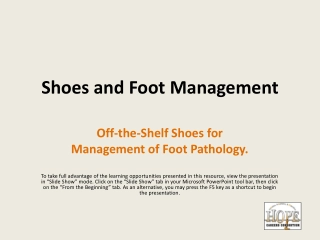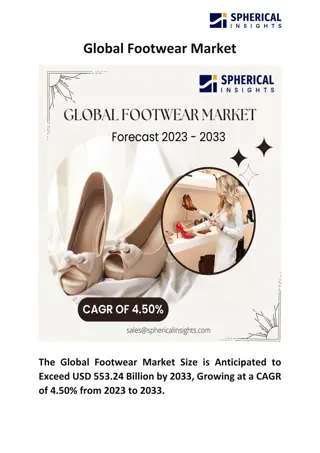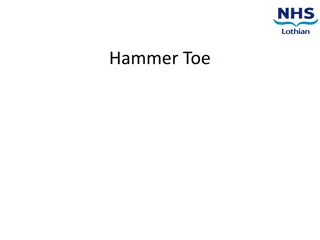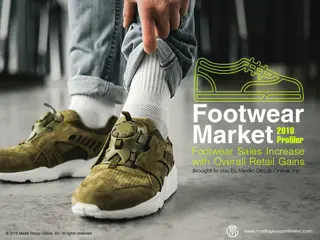Footwear Industry Trends and Consumer Behavior Insights
Footwear retail data from the US Census Bureau shows a significant increase in sales at shoe stores during Q1 2022 compared to the pre-pandemic levels. The industry experienced fluctuations in sales and pricing, with expectations for sales to weaken in the upcoming quarters. Consumer interests have shifted towards outdoor activities post-pandemic, impacting sales of running and hiking footwear. Women's footwear market has shown notable growth, with a focus on health and wellness driving sales. Insights reveal consumer preferences for footwear types and spending patterns for the upcoming seasons.
Download Presentation

Please find below an Image/Link to download the presentation.
The content on the website is provided AS IS for your information and personal use only. It may not be sold, licensed, or shared on other websites without obtaining consent from the author. Download presentation by click this link. If you encounter any issues during the download, it is possible that the publisher has removed the file from their server.
E N D
Presentation Transcript
Footwear Retail Maintains Sales US Census Bureau data shows footwear sales at shoe stores increased by 2.1% during Q1 2022 from Q1 2021, with the $8.38 billion in Q1 2022 sales almost equaling the $8.41 billion in sales for Q1 2019 before the pandemic. The Footwear Distributors and Retailers of America (FDRA) reported July 2022 footwear prices increased 6.2% YOY. The FDRA expects prices to moderate as inventories stabilize. Although sales at shoe stores declined during Q2 and the first half of 2022, they increased compared to 2019, according to the following table of US Census Bureau data.
Industry Inflation The FDRA also reported 87% of shoe company executives expect weaker sales during Q3 and Q4 2022, with two- thirds of surveyed executives not planning new hires, a reversal from a previous survey. Despite static sales and a brighter outlook for the remainder of the year, footwear prices increased 5.8% YOY during the first seven months of 2022, the highest rate in decades. Consumer visits to Designer Shoe Warehouse (DSW) during December 2021 increased by 20.5% from December 2019. The FDRA expects shoe sales at other footwear retailers to remain steady and prices to ease as imports and retail inventories stabilize.
Increase in COVID- Friendly Activities According to the placer.ai, now that many COVID-19 restrictions have been lifted, consumers have more interest in outdoor activities, such as camping, with visits to national parks increasing 9.6% during April 2022 compared to April 2019. While the April 2022 national park visits comparison was promising, May 2022 visits decreased 14.7% YOY despite the larger numbers of consumers participating in outdoor activities since the pandemic began. Of the seven sports the Physical Activity Council measures, fitness sports had the largest 2021 participation rate of 67.3% participation rate, compared to 66.5% during 2020. Participation in outdoor sports during 2021 increased 53.9% YOY.
Women in the Running According to The NPD Group, sales of running and hiking footwear increased 20% during April 2022, compared to 2019, while walking shoe sales increased 30% YO3Y, likely due to 44% of Americans focusing more on health and wellness than they did before the pandemic. The NPD Group also reports women s running shoe sales increased 8.0%, totaling $1.6 billion for the 12 months ending May 2022, and women s products accounted for 49% of the adult running shoe market. For the 12 months ending May 2022, the women s shoe market increased 28% compared to before the pandemic while the men s market increased only 17%. Major brands, such as Adidas, Puma and Under Armour are now creating more women-specific running shoes.
Footwear Consumer Shopping Insights According to a May/June 2022 survey by Footwear Insight, 70% of consumers who said they would be purchasing footwear during spring/summer 2022 were planning on buying sandals or flip flops, followed by running shoes at 66% and casual/comfort at 55%. Of these survey participants, 72% said they anticipated spending the same amount on their shoes, as they typically do, 24% said they anticipated spending more than usual and 4% said they anticipated spending less than usual. A separate 2022 survey published in the July/August 2022 issue of Footwear Insight, found footwear consumers preferences have shifted since the pandemic began, with 46% of those surveyed purchasing more casual/comfortable footwear.
The In-Store Shopping Experience According to the Footwear Insight survey cited above, footwear stores may want to feature more colors, sizes and other options, as 62% of respondents said they shop for footwear in-store but make their purchase online at a site not affiliated with that store. Among those consumers who said they shop at an independent shoe store, 41% rated the quality of footwear assortment as good while 30% rated assortment quality as very good and 16% rated assortment quality as adequate. Independent shoe store shoppers rated sales associates knowledge, compared to other types of stores, at 39% very good, 25% excellent and 24% good. 77% of shoppers said they like having additional colors or styles presented to them by a sales associate.
Advertising Strategies Despite the initial sales decrease during the beginning of 2022, overall shoe sales are still doing well, but footwear retailers would benefit from special offers, sales and new products to consolidate funding on marketing with the continued inflation increase. Advertising footwear for work-at-home or remote office workers remains a good marketing strategy for footwear retailers, regardless of where they advertise, as a large percentage of consumers have changed what they wear depending on where they work. High-end footwear retailers should market to consumers with a household income of more than $100,000 as they will generate more yearly revenue, while bargain retailers should market to consumers with a household income of less than $35,000.
New Media Strategies Millennials and Gen Zers use TikTok and Instagram to search for their next new product or to showcase their brand-new kicks. Retailers can create short videos or post discount incentives who share video reviews of their products to attract new shoppers. With the heightened need for running shoes made specifically for women, those retailers who sell women s running shoes should create promotions or ads on social media or online targeting women who are active or who are looking to be active during the future. Brand Websites should market to Gen Zers as they are 48% of online consumers who shop at brand Websites that sell their footwear, while retailer Websites should market to Boomers who are 42% of online consumers who shop at retailer Websites that sell different brands.























